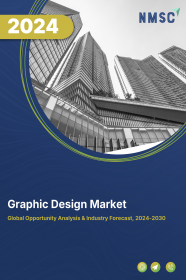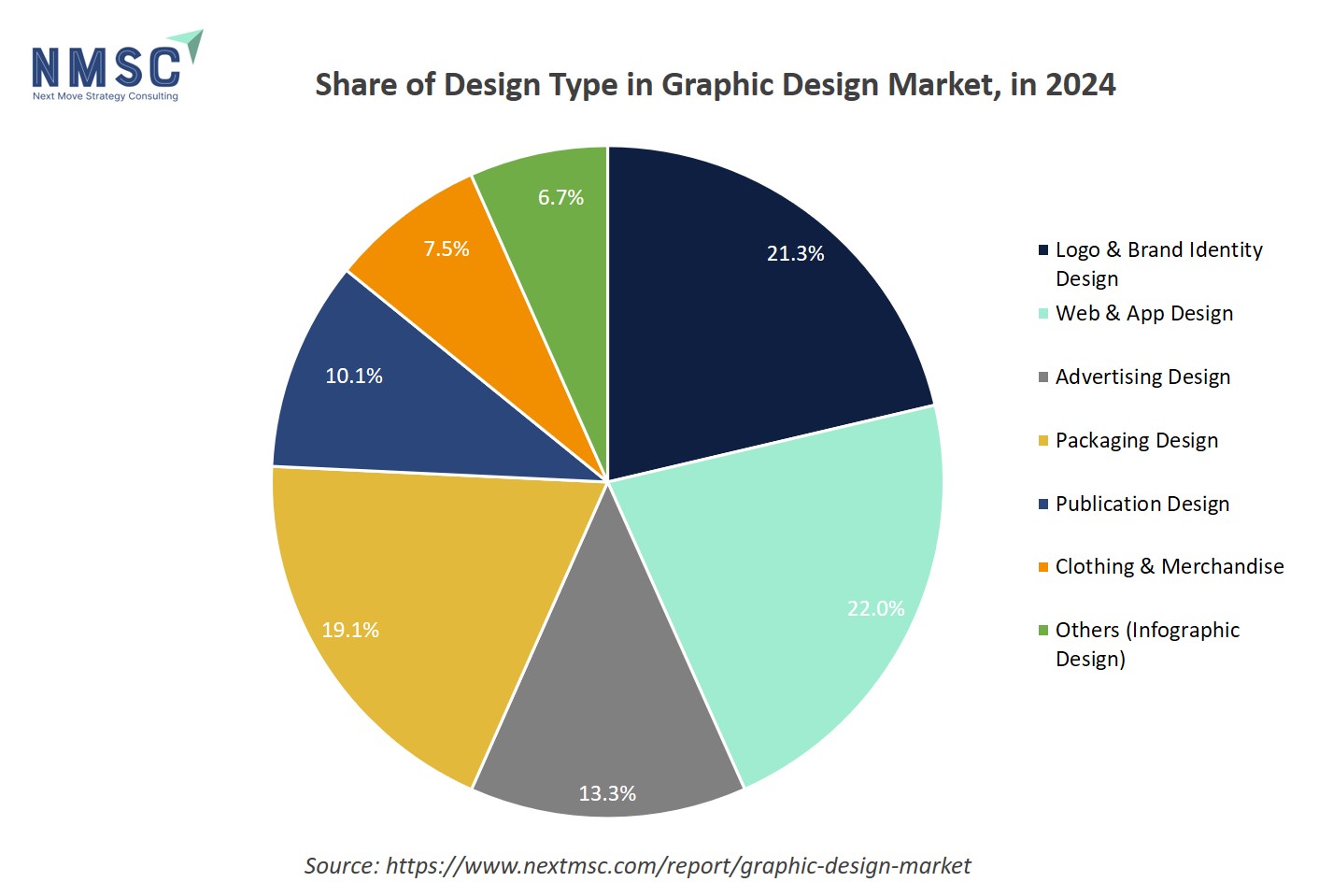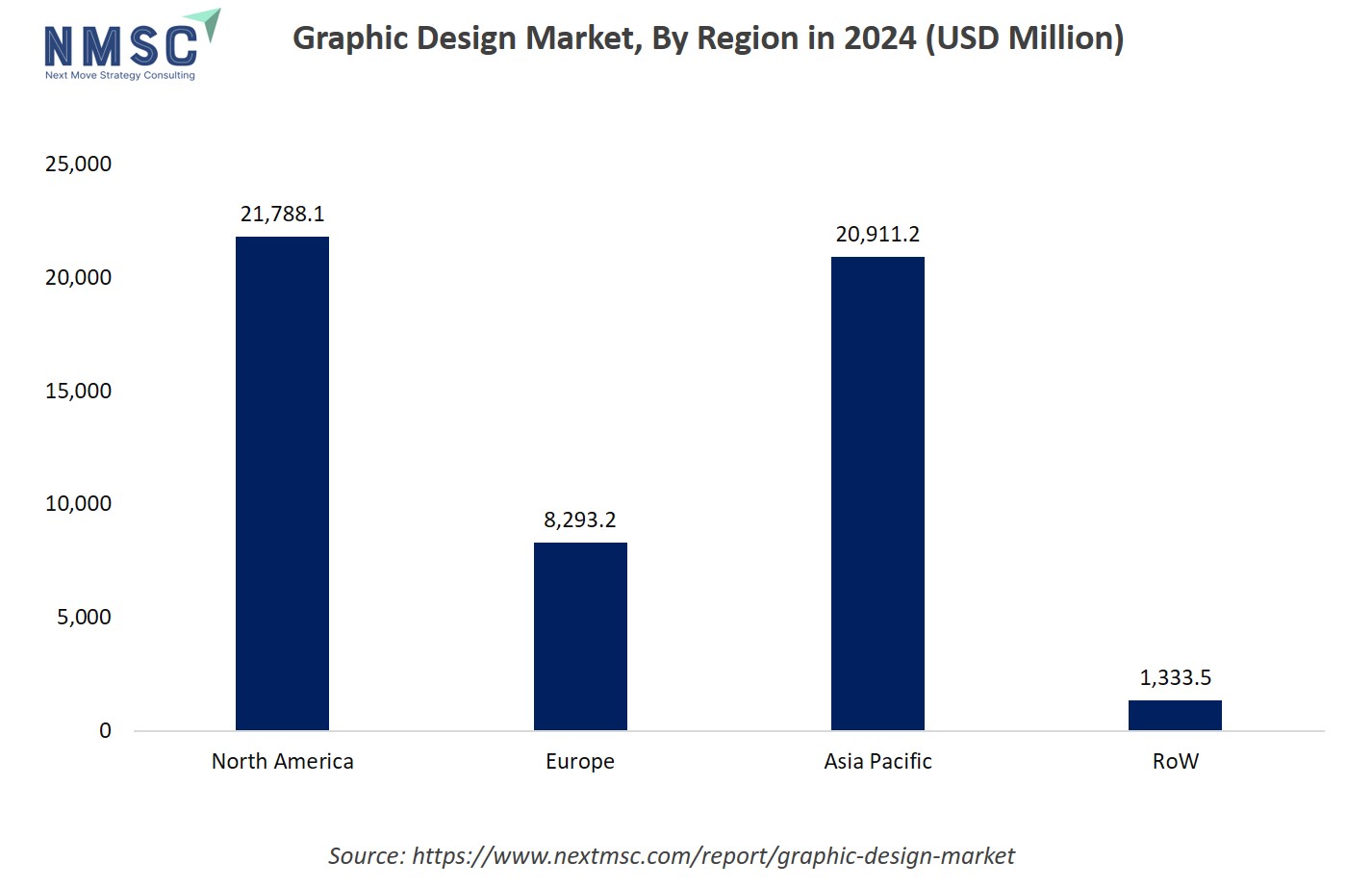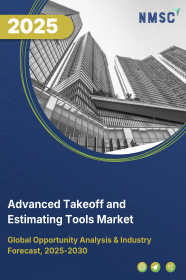
Graphic Design Market by Design Type (Logo & Brand Identity Design, Web & App Design, Advertising Design, Packaging Design, Publication Design, Clothing & Merchandise, Others), by Pricing Model (Project-Based, Hourly-Based, Subscription-Based), by Mode of Delivery (Online, Offline), by Industry Vertical (Media & Entertainment, Retail & E-commerce, Healthcare, Others), by End-User (Small and Medium-Sized Enterprises, Large Enterprises) – Global Analysis & Forecast, 2025–2030.
Industry: Construction & Manufacturing | Publish Date: 01-Nov-2025 | No of Pages: 343 | No. of Tables: 245 | No. of Figures: 190 | Format: PDF | Report Code : CM1164
Industry Outlook
The global Graphic Design Market size was valued at USD 52.32 billion in 2024, and is expected to be valued at USD 56.19 billion by the end of 2025. The industry is projected to grow, hitting USD 70.53 billion by 2030, with a CAGR of 4.6% between 2025 and 2030.
The graphic design sector is undergoing rapid transformation, driven by digitalization, brand differentiation needs, expanding creative economies, and the growing importance of visual communication across industries. Globally, demand for dynamic, user-centric, and visually engaging content is rising sharply, fueled by the surge in e-commerce, social media marketing, entertainment platforms, and corporate branding initiatives.
Expansion of digital media, remote collaboration tools, and AI-powered design platforms further intensifies the need for innovative design solutions, personalized content strategies, and interactive visual storytelling. Advancements in design software, motion graphics, 3D visualization, AR/VR integration, and sustainable design practices are reshaping creative workflows, enhancing user engagement, and strengthening brand identity in an increasingly digital-first world.
What are the Key Trends in the Graphic Design Market?
What are the major technological trends shaping the market?
Technological advancements are revolutionizing the graphic design market trends, enabling designers to create more interactive, efficient, and immersive experiences. The integration of AI and machine learning is transforming workflows through tools that automate layout generation, image enhancement, and branding consistency. Cloud-based design platforms are facilitating real-time collaboration and remote creativity, while augmented reality (AR) and virtual reality (VR) are redefining experiential design, particularly in advertising and retail branding.
Additionally, 3D modeling, motion graphics, and generative design are becoming mainstream, enhancing visual storytelling and audience engagement. Sustainable design technologies, such as eco-friendly digital printing and minimal carbon-footprint production methods, are also gaining traction as brands emphasize environmental responsibility.
How is demographic change influencing the market?
Demographic and societal shifts are reshaping the graphic design market demand as visual communication becomes central to modern lifestyles. The younger, digitally native generation demands bold, interactive, and mobile-friendly designs that align with social media aesthetics and short attention spans. In contrast, older demographics value readability, authenticity, and trust-driven visual elements.
Rapid urbanization, rising disposable incomes, and global digital literacy are fuelling demand for brand storytelling and personalized visual content, especially in emerging economies. These shifts are prompting design agencies and freelancers to adapt styles and messaging to diverse audiences, fostering inclusivity and cultural resonance in design solutions.
What role does government support play in driving industry growth?
Government support plays a pivotal role in advancing the market by promoting digital literacy, creative education, and innovation. Policies encouraging digital transformation, startup incubation, and design education programs are fostering a skilled workforce and boosting creative entrepreneurship. Many governments also fund public awareness and cultural campaigns, generating consistent demand for professional design services.
Moreover, intellectual property protection laws strengthen the value of original design work, while initiatives supporting creative industries and MSMEs enhance market competitiveness. Support for digital infrastructure and smart city development further accelerates demand for motion graphics & animation in public communications, urban branding, and digital services.
How is consumer preference changing in the Market?
Consumer preferences in the sector are rapidly evolving toward personalization, authenticity, and visual storytelling. Modern consumers favor designs that are emotionally engaging, socially aware, and aligned with sustainability values. There is growing interest in minimalist aesthetics, inclusive representation, and brand transparency, while immersive formats like motion graphics, 3D visuals, and interactive interfaces are becoming essential in digital marketing.
Brands are increasingly expected to deliver consistent visual identities across multiple platforms, from packaging to social media, reflecting consumers’ lifestyle aspirations. Overall, the market is shifting from conventional static visuals to dynamic, user-centered, and purpose-driven design solutions that connect creativity with cultural and social relevance.
What are the Key Market Drivers, Breakthroughs, and Investment Opportunities that will Shape the Graphic Design Industry in the Next Decade?
The market is experiencing robust growth, driven by digital transformation and the rising influence of social media marketing. As businesses increasingly adopt e-commerce and online platforms, the demand for high-quality design, spanning UI/UX, social media graphics, and digital advertising, continues to surge.
Social media platforms such as Instagram, TikTok, and YouTube are fueling the need for visually engaging, platform-specific content, while innovations in AR/VR, motion graphics, and 3D visualization are creating new opportunities for interactive and immersive design.
However, the graphic design market expansion faces challenges from intense competition, DIY tools, and pricing pressures. Overall, the sector is evolving into a dynamic, innovation-driven space where creative expertise drives brand differentiation, consumer engagement, and digital presence.
Growth Drivers:
How is Digital Transformation Across Industries Driving the Market Demand?
The accelerating pace of digital transformation is a key driver of the graphic design market growth, particularly as e-commerce and online retail continue to expand. According to the U.S. Census Bureau, retail e-commerce sales reached USD 304.2 billion in the second quarter of 2025, marking a 1.4% increase from the previous quarter.
This steady growth underscores the deepening reliance of businesses on digital channels to attract, engage, and retain customers. As companies intensify their digital presence, the demand for high-quality graphic design, spanning website visuals, UI/UX design, social media graphics, and digital advertising, continues to surge.
In this evolving landscape, brands are prioritizing visually compelling and user-friendly content to stand out in competitive online marketplaces. Graphic design now plays a pivotal role in shaping brand identity, driving consumer engagement, and enhancing the overall digital shopping experience, making it a cornerstone of modern business strategy amid the global wave of digital transformation.
The pie chart depicts the global e-commerce market share by country in 2025. China dominates the market with a 52.1% share, accounting for over half of global e-commerce activity. The USA follows with 20.1%, while the UK and Japan contribute 3.4% and 3.3%, respectively. South Korea, Germany, and France hold smaller shares of 2.5%, 1.7%, and 1.4%, respectively. The remaining countries collectively represent 15.5% under the “Other” category.
The growth of e-commerce is closely driving the market growth, as businesses increasingly rely on visually compelling digital content to attract, engage, and convert online shoppers. High-quality product images, interactive web and app interfaces, social media visuals, and promotional graphics are essential for enhancing user experience and brand visibility on online platforms.
As e-commerce sales surge globally, companies are investing heavily in creative design solutions to differentiate themselves in competitive digital marketplaces, making print design & signage graphics a critical enabler of e-commerce success.
Is Growth of Social Media Marketing Accelerating the Market Growth?
The rapid expansion of social media platforms is a major driver of the market, as businesses increasingly leverage these channels to connect with consumers and build brand awareness. Platforms like Instagram, Facebook, TikTok, LinkedIn, and YouTube demand visually engaging content, including posts, stories, reels, infographics, and video graphics, to capture audience attention in highly competitive feeds.
With brands investing heavily in influencer marketing, paid campaigns, and interactive content, the need for creative, platform-specific graphic design has grown significantly. Designers are now tasked with producing eye-catching visuals, motion graphics, and branded content that not only convey messages effectively but also align with brand identity and platform trends. This surge in demand makes social media marketing a critical driver, fuelling innovation, adoption of advanced design tools, and the overall growth of the sector.
Growth Inhibitors:
How Does High Competition and Market Saturation Limit the Growth of the Graphic Design Market?
One major restraint in the industry is the intense competition and market saturation, particularly with the proliferation of freelance platforms, low-cost design tools, and DIY software. While accessibility has democratized design, it has also led to pricing pressures and reduced profit margins for professional agencies.
Many small businesses and startups opt for pre-made templates or automated design solutions, limiting demand for custom, high-quality services. This saturation makes it challenging for new entrants and smaller agencies to differentiate themselves and maintain sustainable growth.
How is Rising Demand for Interactive and Immersive Design Creating Opportunity for the Market?
A significant opportunity in the graphic design market share lies in the growing demand for interactive, immersive, and experiential design. With the rise of AR/VR experiences, motion graphics, 3D visualization, and gamified content, brands are seeking innovative ways to engage consumers and enhance digital storytelling.
Industries such as e-commerce, gaming, entertainment, and education are increasingly adopting these technologies, creating new avenues for graphic designers to offer high-value, specialized services. This trend not only expands the scope of creative work but also positions graphic design as a key driver of user engagement and brand differentiation in a digital-first world.
How Graphic Design Market is Segmented in this Report, and What are the Key Insights from the Segmentation Analysis?
By Design Type Insights
Which Design Type Is Expected to Drive the Graphic Design Market in 2025?
On the basis of design type, the graphic design market report is segmented into logo & brand identity design, web & app design, advertising design, packaging design, publication design, clothing & merchandise, and others (including infographic design). The Market in 2025 is expected to be primarily driven by logo & brand identity design. Businesses and startups are increasingly investing in creating strong brand identities to differentiate themselves in competitive markets, making logo and identity design the cornerstone of corporate and digital branding strategies.
While other segments such as web & app design, advertising design, and packaging design are gaining significant traction due to the growth of e-commerce, digital marketing, and product launches, logo & brand identity design continues to hold the largest share.
Additionally, the others segment, including infographic design, is emerging as a high-potential category, driven by growing demand for visually engaging, data-driven, and easily shareable content across digital and social media platforms.
The pie chart depicts the share of design types in the Market in 2024. Web & App Design holds the largest share at 22%, closely followed by Logo & Brand Identity Design at 21.3%, highlighting the strong demand for digital presence and brand differentiation. Packaging Design represents 19.1%, reflecting the importance of product presentation and retail visibility, while Advertising Design accounts for 13.3%, emphasizing the need for compelling promotional content. Publication Design contributes 10.1%, Clothing & Merchandise 7.5%, and Others (Infographic Design) 6.7%, showing niche and specialized segments in the market.
This distribution indicates that the market share is heavily driven by digital and brand-focused services, with web interfaces, apps, and visual identity solutions forming the backbone of industry demand. The significant share of packaging and advertising design also underscores the role of graphic design in supporting e-commerce, retail marketing, and product differentiation across industries.
By Pricing Model Insights
Which Pricing Model is Set to Lead the Graphic Design Market in 2025?
Based on pricing models, the market is segmented into project-based, hourly-based, and subscription-based services. The industry in 2025 is expected to be primarily driven by project-based pricing, as businesses prefer paying for individual assignments such as branding projects, website designs, or marketing campaigns. This model provides flexibility for companies to manage budgets while accessing high-quality design solutions tailored to specific needs.
While hourly-based pricing and subscription-based models are gaining popularity, particularly among startups, SMEs, and companies requiring ongoing design support, project-based services remain the preferred choice for one-off, high-impact projects. Additionally, subscription-based services are emerging as a high-growth segment, fueled by increasing demand for continuous, scalable, and cost-effective design support, especially in digital and social media campaigns.
By Mode of Delivery Insights
How are Delivery Channels Shaping the Graphic Design Market in 2025?
Based on mode of delivery, the market is segmented into online and offline services. In 2025, the Market is expected to be primarily driven by offline delivery, as in-studio consultations, on-site creative workshops, and personalized design services remain highly valued for premium and complex projects. Offline delivery ensures direct collaboration between designers and clients, fostering deeper understanding of requirements, richer creative interactions, and highly customized outputs.
While online design platforms, cloud-based tools, and remote collaboration solutions are gaining popularity for their convenience and speed, the offline segment continues to dominate due to its emphasis on personalized experiences, hands-on guidance, and high-quality results. Additionally, offline services are expanding steadily in niche and high-end markets where face-to-face engagement enhances client satisfaction and drives long-term relationships.
The global industry continues to be heavily dominated by offline delivery channels, which account for 77.19% of the market share, reflecting the ongoing reliance on traditional, in-person design services and client consultations. Online delivery, however, is steadily gaining traction, representing 22.81% of the market, driven by increasing digital collaboration tools, remote freelance platforms, and cloud-based design solutions. This trend highlights how the industry is gradually embracing digital channels, enabling greater flexibility, faster turnaround times, and expanded global reach for designers and clients alike.
By Industry Vertical Insights
Which Industries are Driving Demand in the Market in 2025?
Based on industry verticals, the market is segmented into media & entertainment, retail & e-commerce, healthcare, travel & hospitality, technology & telecom, and others. In 2025, the market is expected to be primarily driven by retail & e-commerce, as businesses increasingly rely on visually engaging product listings, marketing campaigns, and UI/UX design to capture consumer attention in highly competitive online marketplaces.
While media & entertainment, healthcare, and technology sectors continue to invest heavily in creative content and digital experiences, retail & e-commerce stands out due to the rapid expansion of online shopping, social commerce, and digital advertising. Additionally, the others segment, including education, finance, and non-profit organizations, is emerging as a growth area, driven by demand for specialized, interactive, and data-driven design solutions that enhance communication and engagement.
By End-User Insights
Which Client Segment is Leading the Market in 2025?
Based on end-users, the market is segmented into small and medium-sized enterprises (SMEs) and large enterprises. In 2025, the market is expected to be primarily driven by large enterprises, as they require comprehensive, multi-channel design solutions for branding, advertising, digital platforms, and corporate communications. Large organizations engage in long-term projects that involve high-quality, strategic, and visually cohesive design services, making them key contributors to the market expansion.
While SMEs represent a growing client base due to increasing adoption of affordable, subscription-based, and project-specific design solutions, large enterprises continue to dominate in terms of spending and scope of design needs. Additionally, SMEs are emerging as a high-potential segment, leveraging creative services to establish brand identity, engage customers digitally, and compete effectively with bigger players in their industries.
Regional Outlook
The market is geographically studied across North America, Europe, Asia Pacific, and the Middle East & Africa, and each region is further studied across countries.
Graphic Design Market in North America
The North American market is being driven by the rapid digitalization of businesses, increasing adoption of e-commerce, and growing emphasis on brand identity and visual communication. Expansion of online platforms, social media channels, and digital marketing initiatives is boosting demand for high-quality, engaging, and user-friendly design solutions.
Companies across industries are investing in website design, UI/UX, motion graphics, and interactive content to enhance consumer engagement and stand out in competitive digital spaces. Additionally, rising awareness of immersive and experiential design, including AR/VR and 3D visualization, is creating further opportunities for innovation in the region.
Graphic Design Market in the United States
In the U.S., the market growth is primarily fueled by the rising adoption of digital marketing strategies and social media-driven brand campaigns. Businesses are increasingly investing in visually compelling graphics, interactive content, and platform-specific designs to attract and retain consumers. The demand for AI-assisted design tools, motion graphics, and 3D visualization is enabling faster workflows and more creative output. Expansion of e-commerce, online education, and digital entertainment platforms further supports market growth, while companies continue to prioritize personalized and immersive design experiences to strengthen brand identity and consumer engagement.
Graphic Design Market in Canada
In Canada, the market is growing due to digital transformation, rising adoption of social media marketing, and increasing demand for visually engaging content. Businesses and organizations are focusing on interactive, mobile-friendly designs for websites, apps, and social campaigns. The growth of remote work, e-learning, and online services is further driving demand for infographics, motion graphics, and branded visual content. Additionally, emphasis on creative storytelling, sustainable design practices, and culturally relevant visuals is shaping market trends and encouraging innovation across the country.
Graphic Design Market in Europe
The European market is supported by the growing importance of digital communication, e-commerce, and social media marketing across industries. Consumers and businesses are demanding creative, immersive, and high-quality visual content for websites, apps, advertising campaigns, and brand storytelling. Innovation in interactive design, motion graphics, and 3D visualization is gaining traction, while sustainable and inclusive design practices are influencing trends. The expansion of digital retail, online services, and tech-driven enterprises is enhancing visibility and accessibility of graphic design solutions, creating opportunities for specialized and innovative offerings across the region.
Graphic Design Market in the United Kingdom
In the U.K., the market is primarily driven by businesses’ increasing focus on digital marketing, social media engagement, and brand differentiation. Urbanization, higher digital literacy, and growing adoption of e-commerce platforms are fuelling demand for visually compelling and interactive content. Companies are investing in UI/UX design, motion graphics, and AR/VR experiences to engage consumers across online channels. The emphasis on sustainable, inclusive, and creative storytelling is shaping design preferences, while government and industry initiatives promoting digital innovation further support the expansion of the graphic design sector across the country.
Graphic Design Market in Germany
Germany’s market is driven by the increasing adoption of digital marketing, social media campaigns, and e-commerce expansion. Businesses are seeking visually engaging, platform-specific content including UI/UX design, motion graphics, and interactive visuals to enhance brand communication. Rising digital literacy and a focus on innovative storytelling are encouraging the use of AR/VR, 3D visualization, and immersive design solutions, while sustainability and inclusive design practices are shaping market trends. The combination of technological adoption and demand for creative, high-quality content is supporting steady growth in Germany’s graphic design sector.
Graphic Design Market in France
In France, the market growth is fuelled by the rise of digital marketing, social media engagement, and the increasing demand for visually compelling online content. Companies are investing in interactive graphics, infographics, and motion design to enhance brand presence across websites, apps, and social platforms. Expansion of e-commerce, digital services, and creative industries is driving adoption of innovative design tools, while trends in sustainable and inclusive design further influence consumer expectations. These factors collectively contribute to the steady growth of the French market.
The 2024 graphic design market revenue demonstrates significant regional variations, as depicted in the bar chart. North America leads the industry with a value of USD 21,788.1 million, reflecting strong demand for creative services across corporate, advertising, and digital media sectors. The Asia Pacific region follows closely at USD 20,911.2 million, driven by rapid digitalization, the growth of e-commerce, and increasing investments in marketing and branding by both startups and established companies. Europe accounts for USD 8,293.2 million, supported by its mature design industry, well-established agencies, and demand for high-quality, customized design solutions. The Rest of the World (RoW) contributes a smaller share of USD 1,333.5 million, highlighting emerging markets with growing opportunities for design services.
This regional distribution indicates that while North America and Asia Pacific dominate in terms of market size, the demand for innovative and digital-first design solutions is increasingly shaping the competitive landscape globally, offering growth potential across all regions.
Graphic Design Market in Spain
Spain’s market is significantly influenced by the growth of e-commerce, social media marketing, and digital content consumption. Urbanization and rising digital literacy are driving demand for interactive, mobile-friendly, and visually appealing designs across websites, apps, and online campaigns. Motion graphics, 3D visualization, and immersive content are gaining traction, while businesses increasingly adopt AI-assisted tools to enhance workflow efficiency. The emphasis on creativity, brand differentiation, and sustainable design solutions is shaping Spain’s graphic design landscape.
Graphic Design Market in Italy
Italy’s market growth is supported by increasing adoption of digital marketing, social media campaigns, and e-commerce expansion. Companies are prioritizing high-quality, interactive, and immersive visuals, including motion graphics, UI/UX design, and 3D content, to strengthen brand identity and consumer engagement. Rising demand for creative storytelling, innovative digital solutions, and sustainable design practices is encouraging adoption of advanced tools and platforms. Combined with growing digital literacy and remote collaboration trends, these factors are driving steady growth in Italy’s graphic design sector.
Graphic Design Market in the Nordics
In the Nordic countries, the market is driven by digital transformation, social media engagement, and high adoption of e-commerce platforms. Businesses are increasingly seeking immersive, interactive, and visually compelling content, including AR/VR experiences, motion graphics, and 3D visualizations. Rising digital literacy, creative innovation, and a strong focus on sustainable and inclusive design practices are shaping consumer expectations. The combination of technological adoption and demand for high-quality, engaging content is contributing to steady growth in the Nordic sector.
Graphic Design Market in Asia Pacific
The Asia Pacific market is fuelled by rapid digitalization, expanding e-commerce, and growing social media adoption. Countries such as China, India, South Korea, and Australia are witnessing strong demand for visually engaging, interactive, and mobile-friendly design solutions. Businesses are leveraging motion graphics, 3D visualization, AR/VR, and AI-assisted tools to enhance brand storytelling and consumer engagement. Rising digital literacy, urbanization, and tech-savvy populations, coupled with the demand for creative, innovative, and immersive content, are creating significant opportunities for market expansion across the region.
Graphic Design Market in China
China’s market is primarily driven by the rapid growth of e-commerce, digital marketing, and social media adoption. Urbanization and rising disposable incomes are fuelling demand for visually engaging, interactive, and mobile-optimized design solutions across websites, apps, and online campaigns. Brands are increasingly leveraging motion graphics, UI/UX design, 3D visualization, and AI-assisted tools to enhance consumer engagement and strengthen digital presence. The growing emphasis on innovative storytelling, immersive experiences, and culturally relevant visuals, coupled with platform-specific content requirements, is driving steady market expansion across China.
Graphic Design Market in Japan
Japan’s market growth is influenced by increasing digital adoption, high social media engagement, and demand for premium, interactive design solutions. Businesses are focusing on immersive visuals, motion graphics, and user-friendly interfaces to enhance brand storytelling and appeal to tech-savvy and health-conscious audiences. E-commerce platforms and online marketing channels facilitate wider reach, while trends toward sustainable, innovative, and aesthetically refined content encourage continuous creative development. These factors collectively support steady expansion of Japan’s graphic design sector.
Graphic Design Market in India
India’s market is being significantly driven by digital transformation, rapid urbanization, and rising internet penetration. Businesses are increasingly investing in UI/UX design, social media graphics, interactive content, and motion graphics to engage tech-savvy consumers. The expansion of e-commerce and online platforms, coupled with growing demand for immersive and innovative visuals, is creating strong growth opportunities. Rising digital literacy and widespread adoption of creative tools are further supporting innovation in design solutions across urban centers, making the market increasingly dynamic and competitive.
Graphic Design Market in South Korea
In South Korea, the market is driven by high digital adoption, social media penetration, and growing demand for visually engaging content. Businesses are increasingly focusing on interactive, mobile-friendly, and immersive designs, including AR/VR experiences, motion graphics, and 3D visualization. The proliferation of e-commerce platforms and modern retail channels is enhancing reach and visibility. Rising digital literacy and a preference for innovative, creative storytelling are supporting sustained growth in the country’s graphic design sector.
Graphic Design Market in Taiwan
Taiwan’s market growth is fuelled by digital transformation, increasing social media use, and demand for creative, interactive, and high-quality visuals. Businesses are leveraging motion graphics, UI/UX design, and 3D content to enhance engagement and brand identity. Expansion of e-commerce and modern retail channels improves accessibility, while trends toward innovative, immersive, and sustainable design solutions create opportunities for differentiation and market expansion across the country.
Graphic Design Market in Indonesia
The Indonesia market is being driven by rapid digitalization, growing urbanization, and increasing social media and e-commerce adoption. Businesses are investing in visually compelling, interactive, and mobile-optimized designs to engage consumers across multiple digital platforms. Rising demand for motion graphics, 3D visualization, and innovative content creation tools is supporting market growth. The emphasis on creative storytelling, immersive experiences, and culturally relevant designs further fuels opportunities for expansion across urban and semi-urban regions.
Graphic Design Market in Australia
Australia’s market is supported by digital transformation, high social media engagement, and growth of e-commerce platforms. Businesses are increasingly adopting interactive, immersive, and visually compelling content, including motion graphics, 3D design, and UI/UX solutions, to enhance brand visibility and consumer engagement. Urbanization and rising digital literacy drive adoption of creative and innovative design practices, while trends toward sustainable and inclusive visual content further promote market growth and innovation across the country.
Graphic Design Market in Latin America
In Latin America, the market trends is primarily driven by rapid digitalization, increasing internet penetration, and growing adoption of social media and e-commerce platforms. Businesses in countries such as Brazil, Mexico, and Argentina are investing in interactive content, UI/UX design, motion graphics, and visually engaging campaigns to connect with urban and tech-savvy consumers. The expansion of online platforms and digital marketing initiatives enhances brand visibility, while demand for innovative, immersive, and culturally relevant design solutions is encouraging creative adoption and market growth across metropolitan and semi-urban areas.
Graphic Design Market in the Middle East & Africa
In the Middle East and Africa, the graphic design industry is supported by rising digital adoption, social media engagement, and e-commerce expansion. Businesses are increasingly leveraging interactive visuals, motion graphics, 3D content, and UI/UX design to strengthen brand presence and engage consumers across online platforms. The growing focus on innovative, immersive, and culturally tailored design solutions, combined with expanding digital infrastructure and creative industries, is driving steady market growth across the region.
Competitive Landscape
Which Companies Dominate the Graphic Design Industry and How do they Compete?
The global market is dominated by a mix of established multinational agencies, creative consultancies, and specialized design studios such as Flocksy LLC, Buttercup Advertising Studio, Fireart Studio, Wolff Olins, Saffron Brand Consultants, Pentagram Inc., ArtVersion, Frog Design, Siegel+Gale, ManyPixels, Duck.Design, DesignCrowd, Design Pickle Inc., Superside, Landor, Pearlfisher, Mucho, Omnicom Group Inc., Chermayeff & Geismar & Haviv, Interbrand, Kimp.io, Designity Inc., Digital Silk, Studio Dumbar, Meta Design, and Wix.com, Inc., Dentsu Group Inc.
These companies compete by offering a broad spectrum of graphic design services, including branding, corporate identity, digital design, UI/UX, motion graphics, 3D visualization, and interactive content, catering to diverse industries and client needs. Market leaders differentiate themselves through innovative, visually compelling, and technology-driven design solutions, emphasizing creativity, storytelling, and immersive experiences.
Strategies also include expanding global and regional client networks, brand visibility, and comprehensive service portfolios. Smaller or specialized studios focus on bespoke, niche, or culturally tailored designs, targeting specific client segments and industries. With rising demand for digital-first, interactive, and immersive design, agencies that integrate advanced tools, creative innovation, and operational efficiency are capturing significant market share and building strong client loyalty in the sector.
Market dominated by Graphic Design Industry Giants and Specialists
The graphic design market is characterized by a mix of large multinational agencies and regional or niche design firms. Major players compete on scale, brand reputation, technological capabilities, and extensive client networks, offering comprehensive services ranging from corporate branding and advertising campaigns to UI/UX and digital content solutions.
Smaller or specialized agencies focus on bespoke, creative, or culturally tailored designs, catering to specific client needs, niche industries, or premium segments. This dual structure allows clients to choose between established agencies for reliability and broad expertise or specialized firms for highly customized and innovative design solutions.
Innovation and Adaptability Drive Market Success
Leading firms in the graphic design market landscape invest heavily in technological innovation, creative software, and immersive design tools to deliver high-quality, engaging, and interactive visuals. Adoption of motion graphics, 3D visualization, AR/VR integration, and AI-assisted design enhance creativity, efficiency, and client satisfaction.
Agencies that adapt to trends like personalization, digital storytelling, sustainability in design, and platform-specific content are securing stronger market presence and loyalty. Continuous innovation in visual styles, interactivity, and user experience is crucial to maintaining a competitive edge.
Market Players to Opt for Merger & Acquisition Strategies to Expand their Presence
Mergers and acquisitions are increasingly being used by graphic design companies to expand service portfolios, enter new geographic markets, and acquire specialized creative expertise. Leading agencies are acquiring smaller or niche firms to strengthen their market share, diversify offerings, and integrate advanced digital technologies.
These M&A activities allow companies to access new client segments, scale operations efficiently, and respond to rising demand for innovative, immersive, and customized design solutions, enhancing their competitive positioning across both mainstream and specialized design sectors.
The 2025 graphic design market is largely fragmented, with Omnicom Group Inc. holding a notable share of 16.18%, and Landor with 0.48% share, while the remaining is distributed among other companies. Omnicom’s position highlights its strong global presence, diversified service offerings, and reputation for delivering high-quality creative solutions. The dominance of the “Others” segment indicates a competitive landscape with numerous small- and mid-sized agencies, freelance networks, and specialized design firms contributing to overall market growth.
This distribution underscores that while top players like Omnicom influence market trends and standards, the bulk of the market is driven by a wide range of providers, reflecting the dynamic, innovation-driven, and highly fragmented nature of the graphic design industry.
Key Players
-
Flocksy LLC
-
Buttercup Advertising Studio
-
Fireart Studio
-
Wolff Olins
-
Saffron Brand Consultants
-
Pentagram Inc.
-
ArtVersion
-
Frog Design
-
Siegel+Gale
-
ManyPixels
-
Duck.Design
-
DesignCrowd
-
Design Pickle Inc.
-
Superside
-
Landor
-
Pearlfisher
-
Mucho
-
Omnicom Group Inc.
-
Chermayeff & Geismar & Haviv
-
Interbrand
-
Kimp.io
-
Designity Inc.
-
Digital Silk
-
Studio Dumbar
-
Meta Design
-
Wix.com, Inc
-
Dentsu Group Inc.
What are the Latest Key Industry Developments?
-
January 2025 - Frog Design presented "Futurescape: 25 Key Trends for the Next Quarter-Century," exploring shifts in technology, culture, and business that impact design.
-
November 2024 - Saffron reimagined the brand identity for digital analytics leader Contentsquare, marking a new era for the company.
-
September 2025 – ArtVersion discussed the evolving landscape of UX design in 2024, focusing on the fusion of technological advancements and human-centered insights.
-
May 2024 - Flocksy introduced new features to streamline project management, making it easier for clients to create and manage design briefs.
What are the Key Factors Influencing Investment Analysis & Opportunities in the Graphic Design Market?
The market is drawing significant investor interest due to the rising global demand for high-quality, innovative, and customized design solutions. Key factors influencing investment decisions include a company’s ability to deliver creative, platform-specific, and immersive content, adoption of advanced design technologies such as AI, AR/VR, and 3D visualization, and operational efficiency in scaling services across diverse markets.
Firms that demonstrate innovation, sustainability, and adaptability in meeting evolving client needs, ranging from mass-market digital campaigns to niche, specialized projects, are particularly attractive. Strategic moves like mergers, acquisitions, and partnerships also signal growth potential, making agencies with diversified portfolios, technological capabilities, and strong market presence prime targets for investment opportunities.
Key Benefits for Stakeholders:
Next Move Strategy Consulting (NMSC) presents a comprehensive analysis of the graphic design market, covering historical trends from 2020 through 2024 and offering detailed forecasts through 2030. Our study examines the market at global, regional, and country levels, providing quantitative projections and insights into key growth drivers, challenges, and investment opportunities across all major market segments.
Report Scope:
|
Parameters |
Details |
|
Market Size in 2025 |
USD 56.19 Billion |
|
Revenue Forecast in 2030 |
USD 70.53 Billion |
|
Growth Rate |
CAGR of 4.6% from 2025 to 2030 |
|
Analysis Period |
2024–2030 |
|
Base Year Considered |
2024 |
|
Forecast Period |
2025–2030 |
|
Market Size Estimation |
Billion (USD) |
|
Growth Factors |
|
|
Companies Profiled |
15 |
|
Countries Covered |
28 |
|
Market Share |
Available for 10 companies |
|
Customization Scope |
Free customization (equivalent to up to 80 analyst-working hours) after purchase. Addition or alteration to country, regional & segment scope. |
|
Pricing and Purchase Options |
Avail customized purchase options to meet your exact research needs. |
|
Approach |
In-depth primary and secondary research; proprietary databases; rigorous quality control and validation measures. |
|
Analytical Tools |
Porter's Five Forces, SWOT, value chain, and Harvey ball analysis to assess competitive intensity, stakeholder roles, and relative impact of key factors. |
Graphic Design Market Key Segments
By Design Type
-
Logo & Brand Identity Design
-
Web & App Design
-
Advertising Design
-
Packaging Design
-
Publication Design
-
Clothing & Merchandise
-
Others (Infographic Design)
By Pricing Model
-
Project-Based
-
Hourly-Based
-
Subscription-Based
By Mode of Delivery
-
Online
-
Offline
By Industry Vertical
-
Media & Entertainment
-
Retail & E-commerce
-
Healthcare
-
Travel & Hospitality
-
Technology & Telecom
-
Others
By End-User
-
Small and Medium Size Enterprises (SMEs)
-
Large Enterprises
Geographical Breakdown
-
North America: U.S., Canada, and Mexico.
-
Europe: U.K., Germany, France, Italy, Spain, Sweden, Denmark, Finland, Netherlands, and rest of Europe.
-
Asia Pacific: China, India, Japan, South Korea, Taiwan, Indonesia, Vietnam, Australia, Philippines, Malaysia and rest of APAC.
-
Middle East & Africa (MEA): Saudi Arabia, UAE, Egypt, Israel, Turkey, Nigeria, South Africa, and rest of MEA.
-
Latin America: Brazil, Argentina, Chile, Colombia, and rest of LATAM.
Conclusion & Recommendations
Our report equips stakeholders, industry participants, investors, policy-makers, and consultants with actionable intelligence to capitalize on the transformative graphic design market potential. By combining robust data-driven analysis with strategic frameworks, NMSC’s Report serves as an indispensable resource for navigating the evolving landscape.





















 Speak to Our Analyst
Speak to Our Analyst

























